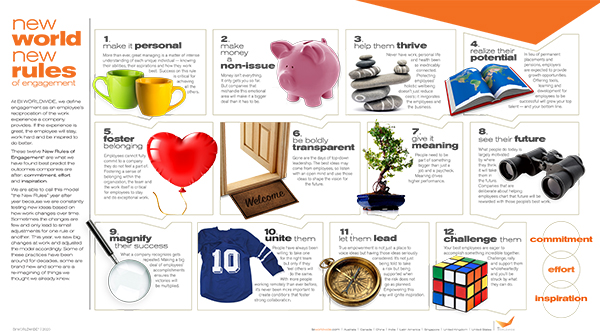Decision day | 10 steps to attracting, recruiting and retaining employees
Written by: Mark Hirschfeld, Vice President, Consulting Services and Strategic Partnerships, BI WORLDWIDE
(View Author Bio)
Over the last year, BI WORLDWIDE has gained insights around the moves organizations can make to secure the right talent. Use the following ten actionable steps to make sure your recruitment and hiring practices are aligned with and supportive of recent changes in the marketplace and your organization.
Scroll Down
____________________
There’s an old joke where a driver is pulled over for speeding. The officer asks why the driver was going so fast and the driver replies:
“I don’t know where I’m going but wherever it is, I’m making record time.”
As leaders, we don’t want to find ourselves going nowhere fast and making record time. This applies to most of our work but is particularly important in how we attract, recruit, select and retain the talented employees that help us move our business forward.
Over the last year, BI WORLDWIDE has gained insights around the moves organizations can make to secure the right talent — moves designed to set a clear course about how we can enhance our brand by attracting and retaining employees who can help us grow.
In our approach to employee engagement, we refer to this as Decision Day - the moments in time where your prospective employees ask themselves, “Can I see myself here?”
Use the following ten actionable steps to make sure your recruitment and hiring practices are aligned with and supportive of recent changes in the marketplace and your organization.
____________________
____________________
1. If your business has changed, who you are looking for has changed.
There used to be a time when every train that left the railroad yards had a “brakeman.” It was an important position but one that changed and mostly went away when technology made it possible for the engineer to slow or stop the train without the use of the brakeman.
Do you have a “brakeman” job, where a role has dramatically changed?
One company we know took a hard look at their sales organization. They were dealing with new product offerings, a different competitive set and changing buyer expectations about what was valued in interactions with their sales reps.
We conducted a study analyzing feedback about sales representatives from customers. Our research indicated a new set of competencies had emerged that predicted sales better than a competency model created several years ago:
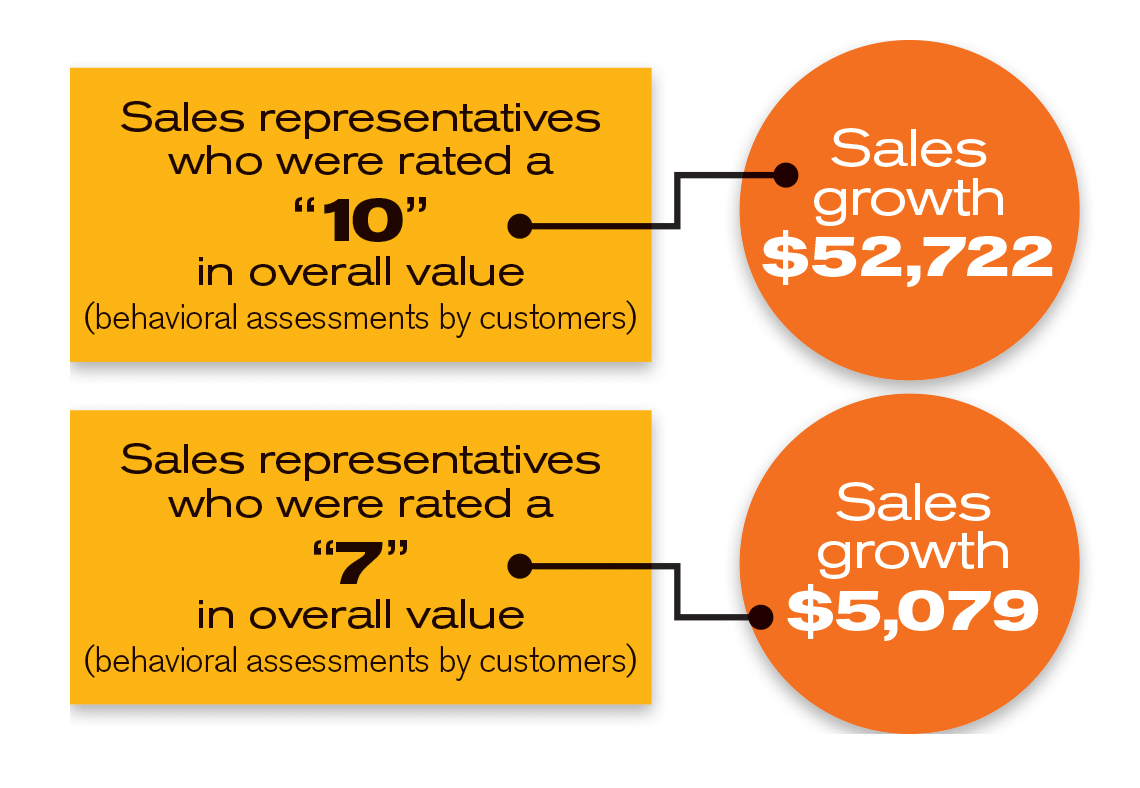
Insights such as these can help an organization develop a business case for who to look for in the marketplace.
Results from these efforts may indicate a need to source in different areas of the job market or what would be of value to those they are seeking to hire. One client found there was a large market of prospective employees who would prefer to work every day but for 25-30 hours instead of the common 40-hour work week. By changing the role expectations, they were able to significantly increase their number of potential applicants and, in doing so, increase their ability to serve more customers.
Here's an example of the development of personas, in this case for a STEM role, that can guide the design of more effective recruitment communications:
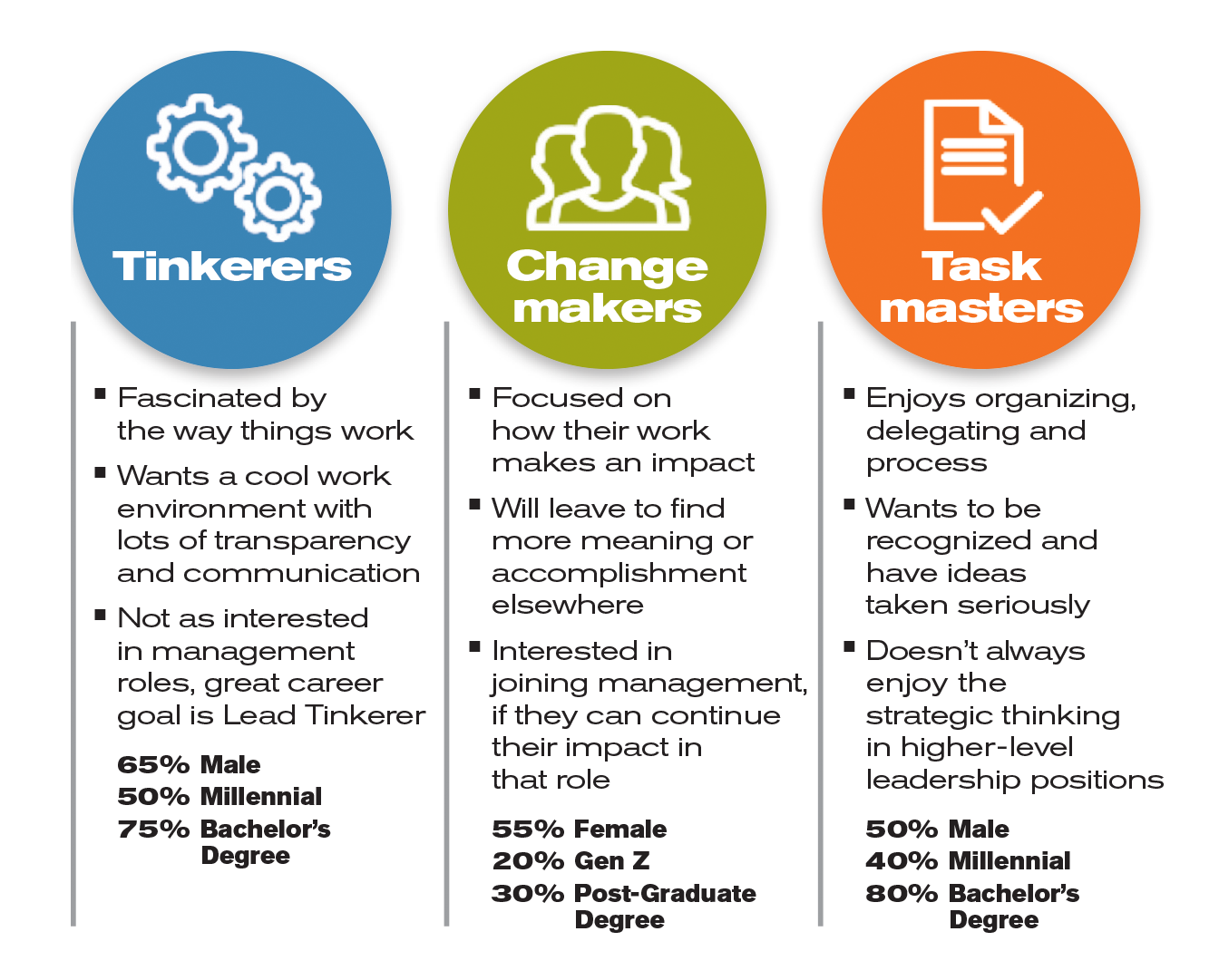
Take action: Has your recruiting process changed to meet these new realities?
Are you:
- Using the same competency model for a job, even though the job has changed?
- Still using the same sources to recruit employees, even though you may be looking for different employees?
- Using the same messages to attract employees even though roles have changed?
- Assessing employees for a set of competencies that are no longer relevant?
- Training and reinforcing to managers the importance of having a slate of candidates that is inclusive of all prospective employees?
- Working to create an even more engaging and inspiring culture, which is the key to retaining employees?
____________________
____________________
2. Help applicants envision the match.
Job applicants want to know that a job for which they’re applying fits their unique skills, interests and abilities. Employers want applicants who will end up staying and performing at a high level so there is mutual interest in making sure there is a good match.
In a recent study we asked employees who had just taken a new job to rate the following statement: “When I was looking for jobs, I felt uniquely suited for the position I am in now.”
A third of our panel who responded to this question did not agree with this statement, meaning they seemed to be in the dark early in the recruiting process regarding whether they were a good match. Those employees who didn’t see how they fit were less likely to be inspired in their current role and less likely to be working hard on behalf of the organization.
The great management consultant Peter Drucker said, “Some managers do a good job of hiring and some managers do a poor job and suffer at their leisure.”
Help yourself out. Describe the job in the recruiting process in such a way that potential applicants are more likely to see how they fit.
You’ll end up suffering less.
Take action:
- Are you clear about the people who can be most successful in the roles you are promoting?
- Have you gained insights from current successful incumbents - those employees you would like to have more of?
- Have you identified the sources from where successful candidates tend to come?
____________________
____________________
3. As an employer, you are unique. Show prospective employees how.
If you’re a product marketer, one of your jobs is to help prospective customers understand how the features and benefits you offer are unique. You need to help them appreciate that what you offer is the only product or service that can meet their requirements and needs. All of this must be done in a highly competitive market where others are vying for the customers you desire. You must stand out. It is the same for employers.
Employers must also “sell” to prospective employees why they are the right place for them, telling a story that is compelling and helps a prospective employee understand how what that employer offers is ideal for them.
We asked a group of employees who had just started with their company to rate the following statement: “When I was looking for jobs, my organization stood out as unique from others I was considering.”
When employees agree with this statement, they are more likely to be engaged, inspired and committed to that job than if they disagree.
In the eyes of prospective employees, we must offer what they think is not only a good job and decent workplace, but one that is unique. Throughout the entire pre-employment process, you will need to show your unique value proposition, from how you tell your story to a candidate gift that reflects the unique experience you offer.
A story that does not stand out will be stood down by others, who will gladly hire the talented employees you cannot attract.
Take action:
- Talk to some of your most passionate employees. What do they believe is unique about your organization?
- Same question to some of your valued customers.
- Same question to some of your valued vendors/channel partners...
- Think about some organizations you believe do an outstanding job of differentiating themselves in a crowded market. They don't have to be competitors, just companies you admire. What can you take away from their approach that would help you stand out?
____________________
____________________
4. Employee orientation starts with the job posting.
Organizations spend a lot of time and money training new employees. This training hopefully helps the new employee get up to speed quickly so they can make contributions to the organization. We also hope new employees will be inspired to bring new ideas and creativity to their jobs.
In our research, we find employees who feel they receive the right training are twice as likely to be inspired, but employees who feel they receive training that was not useful are twice as likely to be uninspired about their work experience.
But what about companies who don’t wait for new employee orientation to help employees learn? Are those employees more inspired?
What we’ve found is new employees who learn about their job and organization prior to being hired are far more inspired than those who don’t. They are, on average, ready to bring their best ideas and creativity to the job.
There are numerous opportunities to help recruits learn about the job and organization, learning that could start with the job posting and continue throughout the hiring process. Yes, in your employment messages you’ll need to tell them about the salary and benefits and where the job is located. Those are table stakes in all employment communications.
But you also need to tell a story. A story that helps prospective employees learn about the job you are asking them to consider and the culture of the organization.
Some of that learning can be targeted to specific segments of prospective employees. One of our clients, a franchisor, found that many of their successful franchisees started out as hourly employees. They knew that not every entry-level person would want that as a future — but some would. So they created videos of successful franchisees that are used in their employment marketing, educating prospective employees of a path that has actually been taken and a story that, in the future, could include them.
New employees have a lot to learn about our workplace. Why not start that learning in the job posting?
Take action:
- Think about some of the key behaviors and outcomes new employees must learn in order to be successful. What would you want to share in your job postings about these behaviors and outcomes?
____________________
____________________
5. Being friendly matters. Not kidding.
In a recent social media post, a prospective employee lamented:
“It doesn’t seem like anyone I talk to at this company about the job they advertised is interested in talking to me.”
Unacceptable.
In our research, when recently hired employees reflected on their experience being recruited by their current employer, not all agreed that hiring managers and human resources representatives were always friendly. When they weren’t friendly, employees who joined the organization weren’t working as hard for the company as when they were.
Recruiting a new employee is the beginning of a relationship with an employer. If a recruiter is having a bad day and is less than helpful or responsive to an applicant, the applicant will sense this. Sadly, applicants often attribute the feelings not to the recruiter but to the employer.
Of course, recruiters can have bad days but as employers, we must be aware that how we relate to a prospective employee can, and does, have an impact on how inspired and engaged that employee will become.
Beyond friendliness, practices such as “ghosting” applicants, where employers never get back to them, must stop. All applicants won’t become our employees but they can certainly be customers or future suppliers or individuals who will share their experiences in ways that can hurt our reputation.
Although technology is supporting much of the recruitment and hiring efforts happening now, human interaction that is friendly and professional still matters.
Take action:
- Have you conducted a study of job applicants regarding their experiences with your organization? What have you learned about friendliness and responsiveness for which you could make improvements?
- Do you have a way of evaluating the performance of all recruiters and hiring managers regarding how they treat job applicants?
____________________
____________________
6. Source more candidates to keep more hires.
When ordering your favorite dish from a restaurant, it’s nice to have a choice of how your meal is cooked or which salad dressing you prefer.
Choice is a good thing.
When it comes to recruiting, having a choice, it turns out, is a very good thing.
According to our partner Dr. Merle Riepe of SOLVE, one employer saw significantly improved retention when hiring managers had more candidates from which to choose. The organization hires thousands of employees across the United States.
If a hiring manager had, on average, three or more candidates to consider for an open position, their annual turnover was one-third that of a hiring manager who only had one candidate to consider.
In speaking with hiring managers and HR professionals as to why this happens, a couple of ideas emerged. First, hiring managers who have more candidates to choose from may be more likely to select who they think is the best candidate. Additionally, the hiring manager may feel more “ownership” for the candidate they hire if they have other choices, leading them to want to invest more in their success.
Having a choice of candidates is important in developing a committed team. This puts even more emphasis on increasing our sources of candidates, those who are actively looking and those so-called “passive candidates” who might not be currently looking but if presented with the opportunity, would be very interested in our offer.
Take action:
- Are you considering new sources of potential talent?
- Is your messaging inspiring the right candidates to apply?
- How well are you tapping into your current employees for referrals?
- Are your recruitment communications telling the story of how you are unique?
____________________
____________________
7. If you want a more diverse candidate pool, examine the bias in your hiring practices.
One CEO we work with recently stated:
“My current sales and service organization does not reflect the demographics of our customers. I consider that an existential problem.”
“Existential”—sit with that for a moment. The consequences of failing to create a more diverse workforce could not be higher.
Many organizations are putting additional emphasis on making sure their candidate pool reflects the diversity of the communities in which they work and live. It’s not only the right thing to do but this CEO is correct in that having a more diverse workforce will have a positive impact on their customer experience.
Where do we begin? Dr. Johné Battle of Dollar General recommends asking: “Who are we excluding right now?” The answer to this question may help us determine how we will broaden our hiring process to include new sources of candidates who can contribute to our organization.
We need to explore every part of our recruitment and hiring process. Do our job postings have content for which there is implicit bias? Do we ask questions in the pre-employment process that are biased against certain parts of our community?
Once hired, we need to do even better to create an inspiring, engaging workplace where everyone feels like they belong. According to our research, the cultural factors that most predict a sense of belonging are when employees:
- Believe their jobs matter
- Don't feel isolated
- Are recognized when they do good work
- Are confident they can fulfill their potential and grow with the organization
- Trust leadership
- Feel supported when they make mistakes
- Have managers that make decisions in the employee's best interest
- Have their ideas taken seriously
- Feel the organization is open to different points of view
There’s a great planning exercise called “start, stop, continue.” Focus this exercise on creating a more diverse and inclusive workplace—what will you stop, start and continue?
Take action:
- Who are you excluding? It's a difficult question but it deserves an honest answer. Take a hard look, then build your plan from there.
- Conduct a review of your entire pre-employment process. Identify and remedy all practices for which there may be bias.
____________________
____________________
8. Everyone on the payroll must be a recruiter.
“We have 10,000 employees. It is my goal that every one of our employees will be great advocates for our company and refer others to work here.”
So said the CEO of an organization that is frequently listed as a “best place to work.”
Research suggests this CEO is on to something. The cost to hire referred employees is significantly lower and numerous studies have reported that on average, referred employees stay longer.
Our own research supports this focus on employee referrals: Current employees in our panel studies who were referred report being far more engaged than those who were not referred.
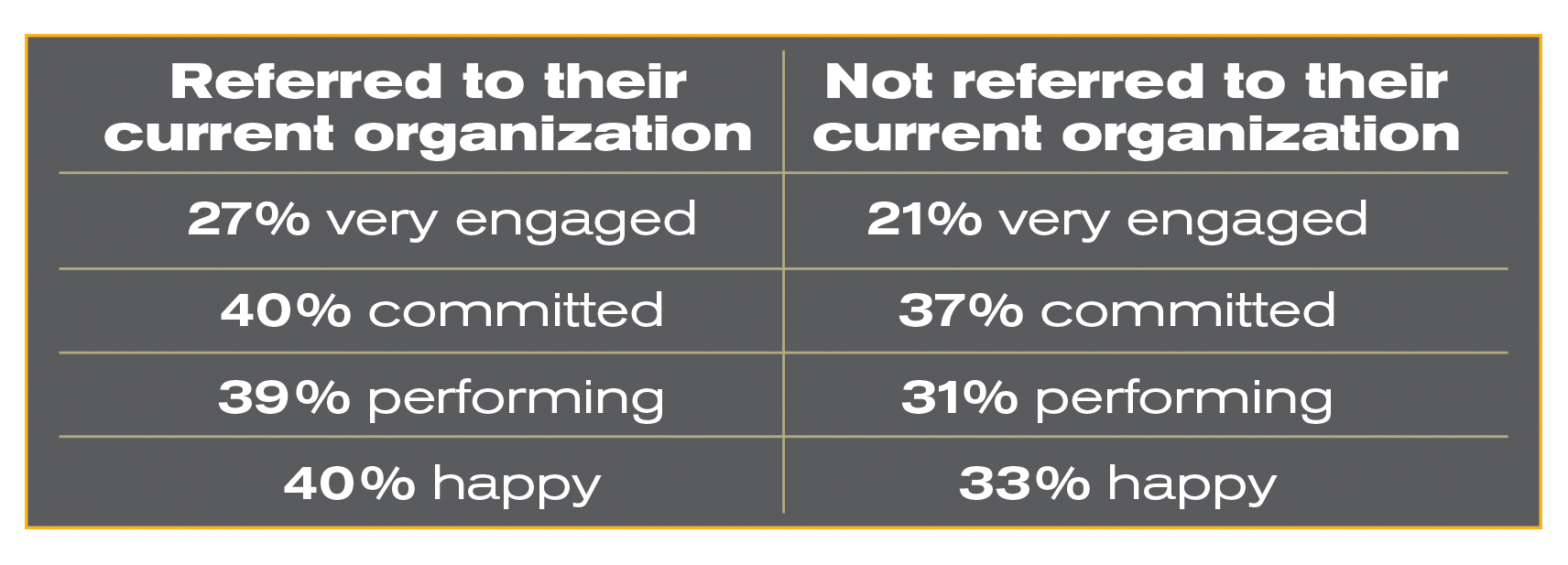
Are there positions or regions where recruiting is more challenging and, if so, are you investing appropriately to recognize those referrals? Can you really get your employees to be recruiters? One financial services company we work with has had an active referral program for their sales organization. At last count, over half of their current sales representatives were referred. As with many organizations, they provide recognition for employees who refer sales representatives who are still with them six months later; in this case, with points deposited in their recognition program account.
Companies who inspire current employees to refer candidates for open positions realize many positive benefits.
Take action:
- Do you have a way of recognizing people who refer new employees?
____________________
____________________
9. Appeal to the changing values of job seekers.
A leader of a growing company determined it was in the best interest of his business in the attraction and retention of employees that he raise their wages. In doing so, his company was able to build a loyal workforce and surged ahead in a fiercely competitive market.
That leader was Henry Ford when he established a daily wage of five dollars in 1914.
This story is one of many over the years, where leaders presented a new value proposition to the job market to effectively attract and retain the employees required to achieve their mission.
The pandemic has again changed the way we look at so many things, including how job seekers value a prospective employer, and employers will need to understand how they can appeal to job seekers who have very different views about what is important to them in their work experience.
According to our research, several factors related to commute time, working from home and travel are now more important than prior to the pandemic:
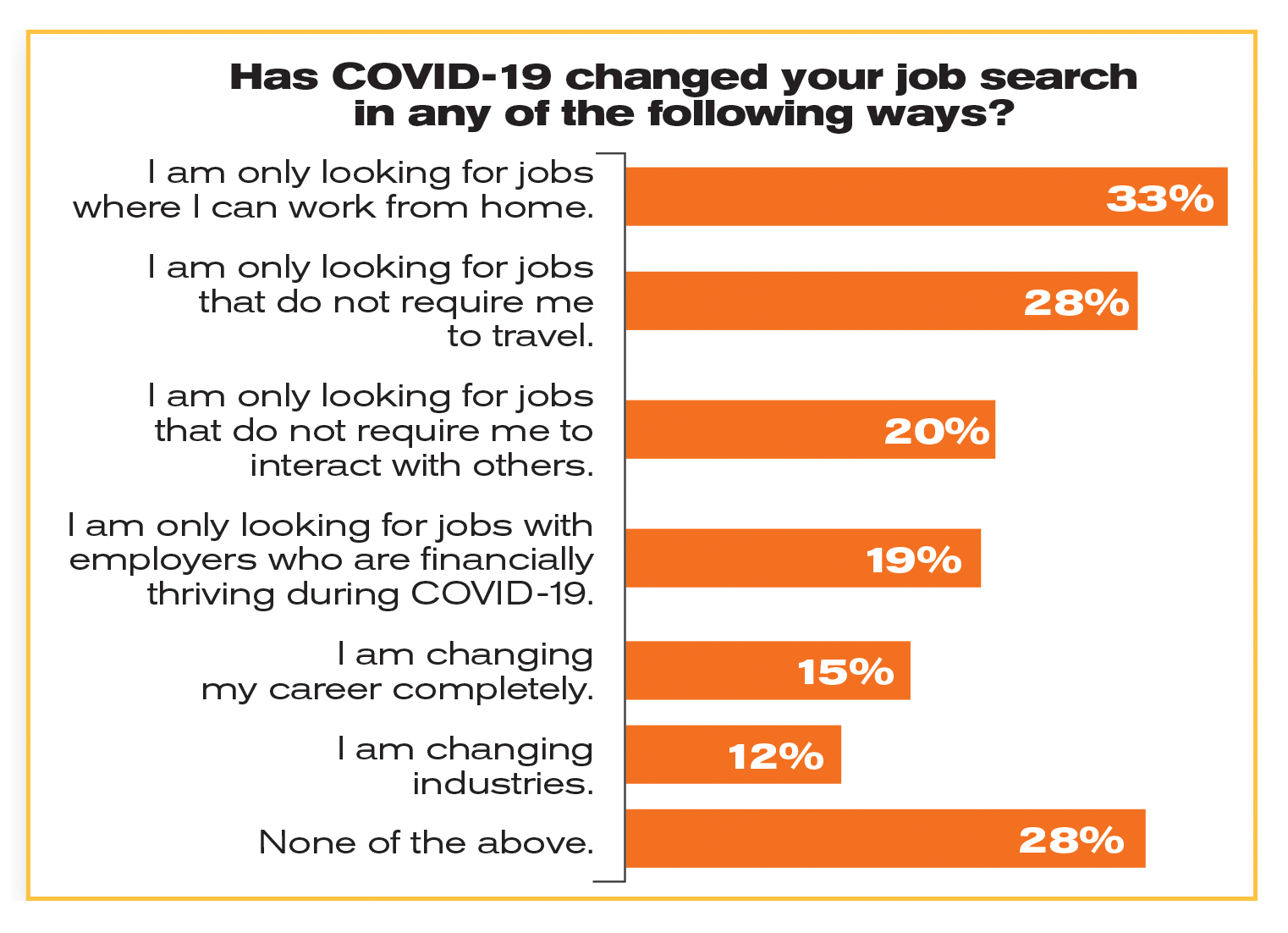
Employers have had to amend the work experience in a way that attracts and retains employees before—this is not the first change and it certainly won’t be the last.
Addressing these emerging trends may also require changing who the company would want to recruit and how they would communicate in a way that attracts prospective employees whose interests and goals are aligned with our value proposition.
These emerging trends may vary a bit going forward but employers who begin to account for these changes now will be in an even better position to attract and retain a workforce that helps them achieve their goals while offering a work experience that meets the emerging values of job seekers.
As General Eric Shinseki so famously said: “If you don’t like change, you’re going to like irrelevance even less.”
Understand and embrace these changes in job seeker expectations and, in doing so, thrive.
Take action:
- What have you learned from these changing times that may impact how you scope the roles and responsibilities for a job?
- Are there "mindsets" you had about a job that were relevant a few years ago but are now getting in the way of you re-imagining that job?
- Although there may be some negative impact to change, what are some positive things that could come from this re-imagining? For example, might you be able to tap into other candidate sources that you couldn't previously?
____________________
____________________
10. Retaining great hires begins and ends with an inspiring culture.
To be competitive, we must develop even more engaging, inspiring places to work, where new employees want to work and will thrive.
For the last ten years, we’ve been studying the elements that make for that kind of environment and have identified the twelve factors that predict greater employee commitment, effort and inspiration. We call this model the New Rules of Engagement®. The key for succeeding is to build an awesome culture which takes the rules and makes them live meaningfully throughout your workplace, starting with the executive team and being felt by each member of your team.
You want each of your new hires to feel welcomed, appreciated, valued and included. Embrace the New Rules and enjoy the benefits of your efforts.
Take action:
- Review the New Rules of Engagement model. What are the two or three factors you believe are important to your organization?
- Identify ways you can improve how employees feel about these rules.
Read our New Rules of Engagement® here.
____________________
____________________
Make every moment count.
At BI WORLDWIDE, we study employees. What motivates them. What engages them. What earns their trust and loyalty.
The result is a collection of data we call the New Rules of Engagement® and what we use to inspire them to be their best.
Getting your strategy right for Decision Day, when a prospective employee first starts to consider your company as an employer, will create a solid foundation on which to care for the entire employee experience: their First Day, to Every Day work culture, to recognizing them on Achievement Day and finally, ensuring they become advocates on Referral Day.
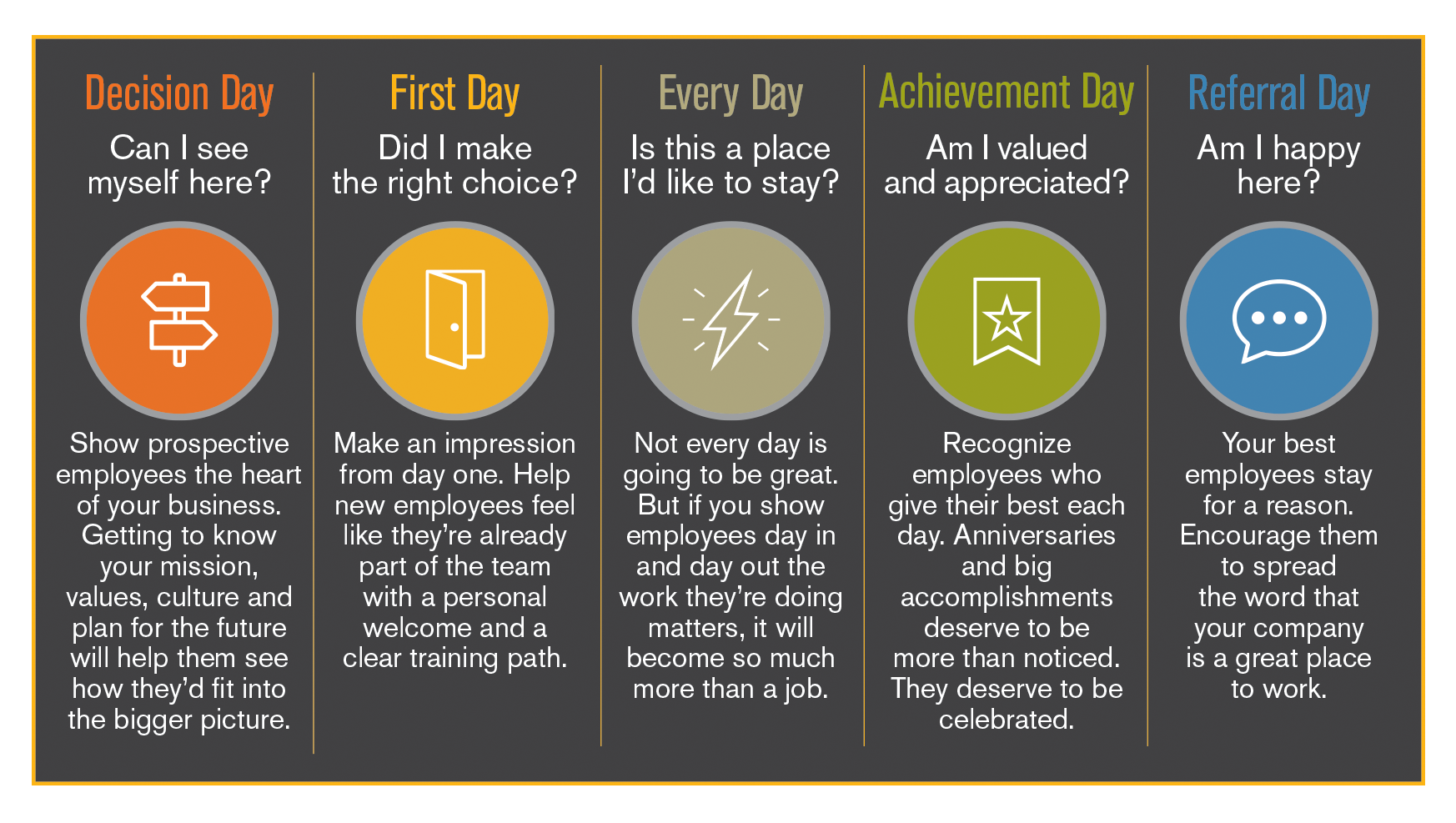
Ready to enhance your recruitment strategy?

